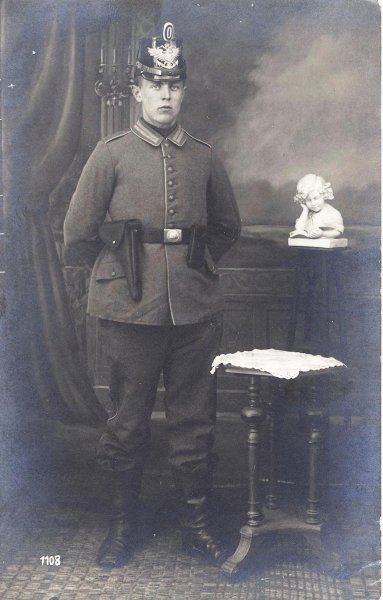
Text Resize
buttons
Background – Marinekorps Flandern
It had been instituted under the leadership of Admiral von Schröder on September 3, 1914, and played an honourable part in the taking of Antwerp on October 10, 1914. The General Command had its headquarters at Bruges. The infantry of the Naval Corps consisted of six regiments of able seamen and the marines. The latter in particular had played a distinguished part in the great battles in Flanders in 1916 and 1917. The sea-front was guarded by regiments of marine artillery. Thirty guns of the heaviest calibre had been set up there, among them five of 38 cm., four of 30.5 cm., and besides them a large number of quick-firing guns of from 10.5 to 21 CM. calibre.
Memoirs of Admiral Scheer.
The Marinekorps initially consisted of one Marine (Matrosen) Division but a 2nd Division was raised in November 1914. The 1st Division staff occupied the seafront from Raversyde to the Zeeland frontier, while the 2nd Division was allocated the front on land from the North Sea to Schoorbakke (4 kms SE of Nieuport). The six regiments of Matrosen alternated between the two sectors, and consequently changed from one division to the other. The Marinekorps also had its own fighter and seaplane Flugs, and had numerous artillery batteries dug in along the Flanders coast. A heavy gun railway battery was also available.1
The Pistolen 04 – the Shako Marine infantry – and Flanders
Shown below are two extremely rare, staged pictures of a typical Imperial Navy Shako Marine Infantry machine gun detachment landing party, i.e. Kaiserliches Marinekorps with all the associated accoutrements. Both pictures are in the form of a postcard. One picture was probably taken in a park as evidenced by a park bench, small picket fence, and buildings in the background and the other in the woods.

The equipment in the foreground of the "picture in the park" is one of the early pre-WW1 rangefinders or Entfernungsmesser used with the machine gun or Maschinengewehr, a Naval Model MG94 (the long folding tangent sight is distinctive), and the soldier, center front, has the carrying case for the rangefinder over his shoulder. The MG94, with brass jacket, is the first model adopted by the Navy, with its unique Naval model mount. These MG94s were retained in service on this Navy tripod for ground use by landing parties and in the trenches through WWI. The Kaiserliches Marine used the MG94 on board ship with a pedistal mount. Production of the 1894 style brass Naval Maxim MG942 was discontinued after 1908 when production of the Naval MG08 was started. At the rear of this group is the MG cart, used to carry both the MG, tripod, and ammo boxes into action. The ammo boxes are standard Patronenkasten 88 (cartridge cases) for the MG belts. The rifles carried are the Gewehr 98. The "picture in the park" does not seem to have any Imperial German Army connection. The picture features just Naval Marines, with a regular uniform sailor pictured in the group.
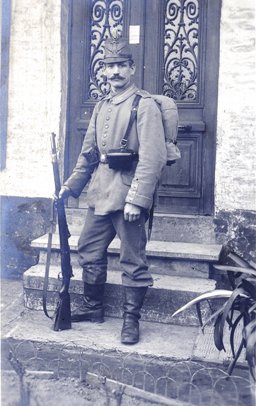
|
The cloth or felt covered Shako head dress shown on the Infantry soldiers in the picture above has a grey Imperial Eagle over anchor helmet plate with a field badge on the top front of the helmet. Pictured are three of the field badges or Feldabziechen – a wooden rosette covered with cloth bearing the state colors, worn on top of the helmet. An example is pictured on the left of a typical Marine infantry soldier with an identical Feldabziechen. Listed below are two styles of Shako Marine helmets:
|
The second picture shown below is similar to the previous one, but set in the woods with a similar combination of marines, P.04 rigs, MG94s, MG94 carts and other equipment. The regular seaman standing between the two Shako Marinekorps in the standard dark blue uniform and cap with a cap ribbon or Muetzenband that reads Kaiserliches Marinekorps indicates that he and the group are indeed, of the Kaiserliches Marinekorps. Furthermore, the rear side of the postcard reveals that the picture was taken by the Wahrmann Studio, Lockstedter Camp located near the Hülsings Hotel. Altier Wahrmann. Lockstedter Lager neben Hülsings-Hotel which translates: Wahrmann Studio. Lockstedter Camp near (the) Hülsings-Hotel. However, the cancellation stamp on the back of the picture post card states that the post card was mailed from the I. Ersatz-Seebataillon or the First Replacement-Sea Battalion i.e., the Marine Infantry, which was based in Kiel.

Click to view close-up of picture.
Lockstedter Lager is located in the town of Lockstedt in northern Germany between Wilhelmshaven and Kiel. It was a known training area for the Imperial Germany Army and apparently as well, the training area of the German Marine Infantry prior to WWI for about 18,000 soldiers on an area of 60 square kilometers in the most northern German state Schleswig-Holstein. Lockstedt (er) Lager just means Lager or Camp of Lockstedt.
The Wahrmann studio probably was a local photo studio of the camp located near the Hülsings Hotel, a good place to earn money considering that the soldiers were trained there only a few weeks or month, so there were more than enough photos to make. Per information located on the Internet the Hülsings-Hotel today is called "Zum Kamin" or Fireplace.
There are, relatively speaking, many pictures of the regular navy posing with their P.04 rigs, usually part of a Marine Akademie graduating class. However, the Shakos in the subject picture shown above are those of the Marine Infantry in a landing party. This was the intended use of the P.04 when first adopted, and the mixture of arms is typical of such a machine gun detachment, as a landing party – mostly seen in Colonial settings.
Actual Shako Marine Infantry Landing Party
Also shown below is a picture of Marinekorps officers going over battle plans and a rare set of three Imperial German Navy Marine Infantry landing party pictures. As stated on the back side of the Marinekorps officers photograph, this is an official photograph released by the Deputy General Staff for publication. The Navy Office (Reichsmarineamt) release statement is on the backside of one of the Marine Infantry landing party photographs.

Click to view next picture.
The determination that the officers pictured are Marinekorps officers is based on the uniforms, specifically the officer with the pointing stick who is wearing a Marine infantry model 1910 officers Waffenrock or tunic and Marine infantry officers cap4.
These are rather large 5" x 7" format pictures and when originally taken were not intended for general publication, as were the more common, smaller format postcard pictures. These larger pictures were probably taken in 1916-17 for propaganda or political purposes, probably in Flanders. The following pictures show a column of Imperial Navy Shako Marinekorps Infantry in field uniforms with belt secured Pistolen 04 rigs. Also pictured with the troops are most of the military paraphernalia shown in the two staged post card format landing party pictures; one in the park and the other picture in the woods.
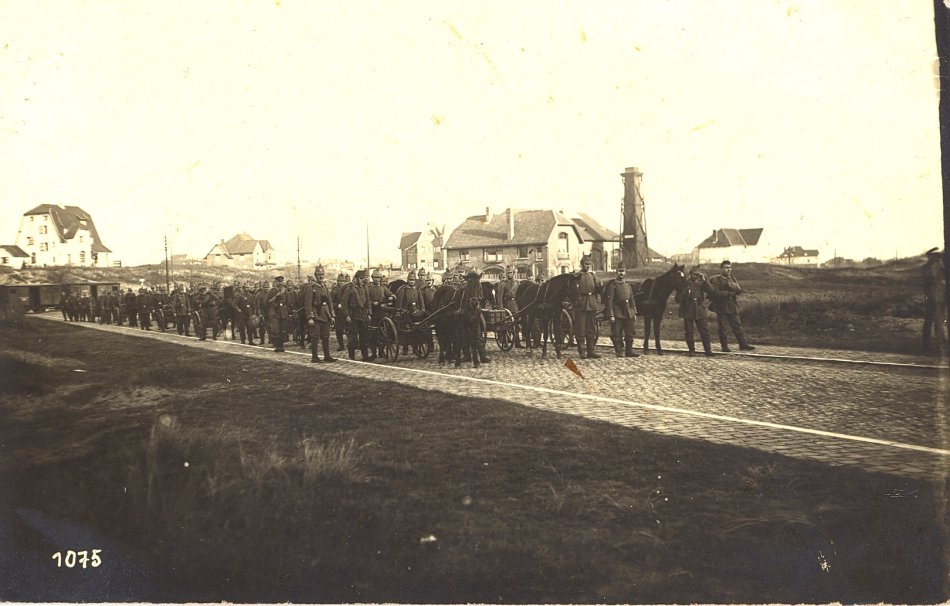
Large column of Marines marching down a cobblestone road, showing a railroad in the left background, possibly involved in transport.
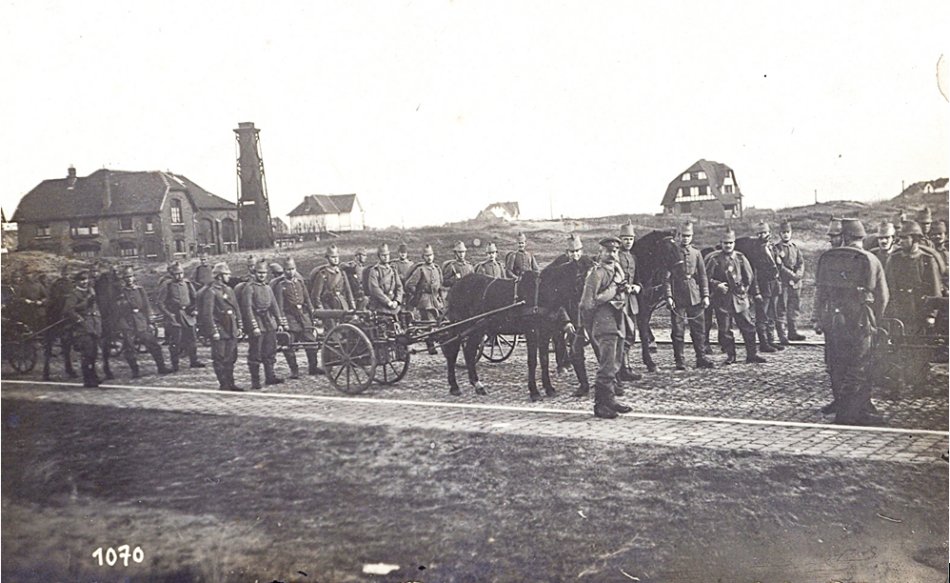
Closer look at forward Marine Infantry column, posing for picture.
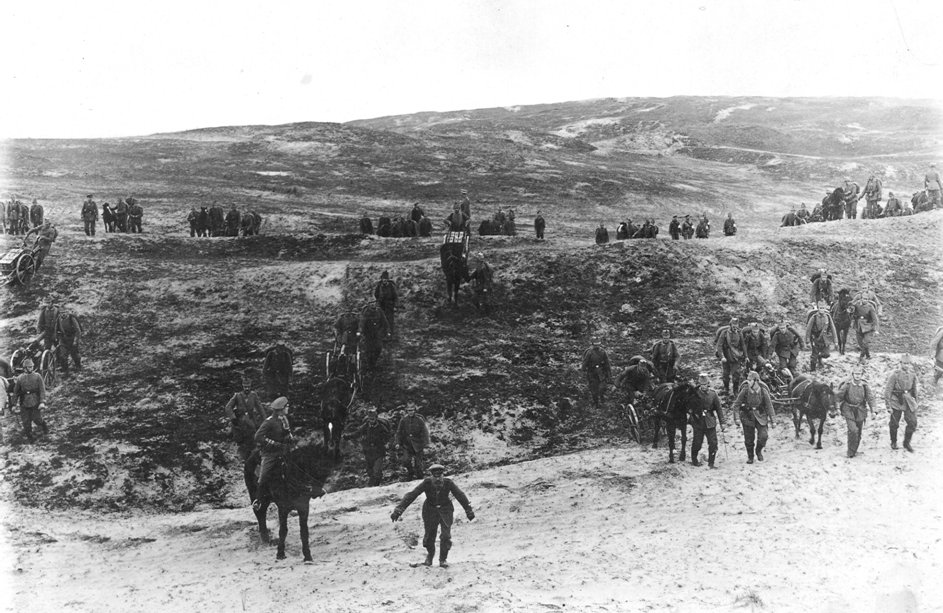
View showing the same Marine Infantry traversing sand dunes.
An additional picture showing regular German Sailors, possibly Marineinfanteriekorps in Antwerp with Gewehr 98 rifles and officers with complete Pistolen 04 rigs. Antwerp being the capital of the Antwerp province in Flanders.
Kaiserliche Marine stationary seals relating to the Marinekorps and Flanders; Inspection of the Marine-Infantry and Commander of the Flanders Submarine Fleet.
Flandernschlacht 1917
Pictured is a small section of a map insert entitled Übersichtskarte von Belgien und Nordfrankreich or General map of Belgium and Northern France. This insert section is a smaller part of a rather large three by two foot original tactical World War 1 German military map entitled Flandernschlacht 1917 (Flanders battle 1917). The map was issued with the 1920s German WW1 battle history book series 'Das Reichsarchiv'.
 Home page
Home page

